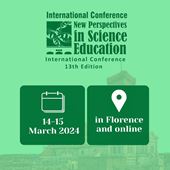Sorting Materials using Programmable Lego© Robot: an Educational Activity to Promote Sustainability among Youngsters
Andrea Ienco, Consiglio Nazionale delle Ricerche, Istituto di Chimica dei Composti OrganoMetallici (CNR-ICCOM) (Italy)
Bruno Tiribilli, Consiglio Nazionale delle Ricerche, Istituto dei Sistemi Complessi (CNR-ISC) (Italy)
Chiara D’Errico, Consiglio Nazionale delle Ricerche, Istituto di BioEconomia (CNR-IBE) (Italy)
Armida Torreggiani, CNR-ISOF, Institute for Organic Synthesis and Photoreactivity, National Research Council (Italy)
Valentina Biasini, Consiglio Nazionale delle Ricerche, Istituto di Scienza, Tecnologia e Sostenibilità per lo Sviluppo dei Materiali Ceramici (CNR-ISSMC) (Italy)
Sabrina Gualtieri, Consiglio Nazionale delle Ricerche, Istituto di Scienza, Tecnologia e Sostenibilità per lo Sviluppo dei Materiali Ceramici (CNR-ISSMC) (Italy)
Pietro Galizia, Consiglio Nazionale delle Ricerche, Istituto di Scienza, Tecnologia e Sostenibilità per lo Sviluppo dei Materiali Ceramici (CNR-ISSMC) (Italy)
Abstract
Educational robotics offers countless opportunities for group work and self-evaluation [1,2]. At the same time, it can be used for presenting scientific concepts and it can help to develop scientific thinking, inquiry practice, information literacy competences, and attitudes and accountability as well as the enviromental awareness. In the framework of the European Green Deal and the national project “Change the Game: Playing to Prepare for the Challenges of a Sustainable Society” [3], we engaged groups of students in two learning paths focused on building and programing robots able to face the material recognition and reclycling. The pathways were developed in two weeks extracurricular stage in institutes of the Italian National Council of Research (CNR) and were based on colour sensing, deal with the sorting of different materials: (i) plastic caps and (ii) mosaic tiles. Lego© Spike Essential kit were used as hardward and software tools. LEGO robotics is a powerful educational tool, allowing with students leveraging their knowledge and experience to solve a real-world problem and to easily explore topics in product design and prototyping. Moreover, the flexibility of the LEGO building system allows every student team the opportunity to approach a given problem differently allowing students to learn from each other and forcing the students to find evidence to support their design ideas and their scientific results. The learning paths began with an introduction to the scientific topic and continue with the mechanical construction and programming of the robot. During the two weeks, meetings were organized with other researchers and experts and finally, the students presented their creations to the public. In the case of the robot sorting caps, colour selection allows the efficient recycling of plastic (HDPE) for the production of new objects with well-defined colour characteristics [4]. As regards glass mosaic tiles, they are often obtained from production residues that are marketed in the bags of multicolour fragments. The need therefore arose to automatically separate the glass tiles based on their colour to relieve the artist from this tedious task. Different convincing solutions both in the mechanical assembly and in the software development have been obtained thanks to the creative work of the groups [5,6]. At the end of their extracurricular stages the students have been asked to run a workshop in which they presented their robot projects to small groups of other students and helped them build the robots, thus reinforcing their skills and transferring them to their peers, in a virtuous learning circle.
|
Keywords |
STEM, LEGO, Recycling, Sorting, School |
|
References |
[1] Int. J. Adv. Robot. Syst. 11:2 (2014) 27–41. https://doi.org/10.5772/58249 [2] Physics Education 54:6 (2019) 065013. https://doi.org/10.1088/1361-6552/ab3e25 [3] https://www.changegame.cnr.it/ [4] Zenodo (2023). https://doi.org/10.5281/zenodo.7729132 [5] Zenodo (2023). https://doi.org/10.5281/zenodo.8150431 [6] Zenodo (2023). https://doi.org/10.5281/zenodo.8150470 |
 New Perspectives in Science Education
New Perspectives in Science Education


























